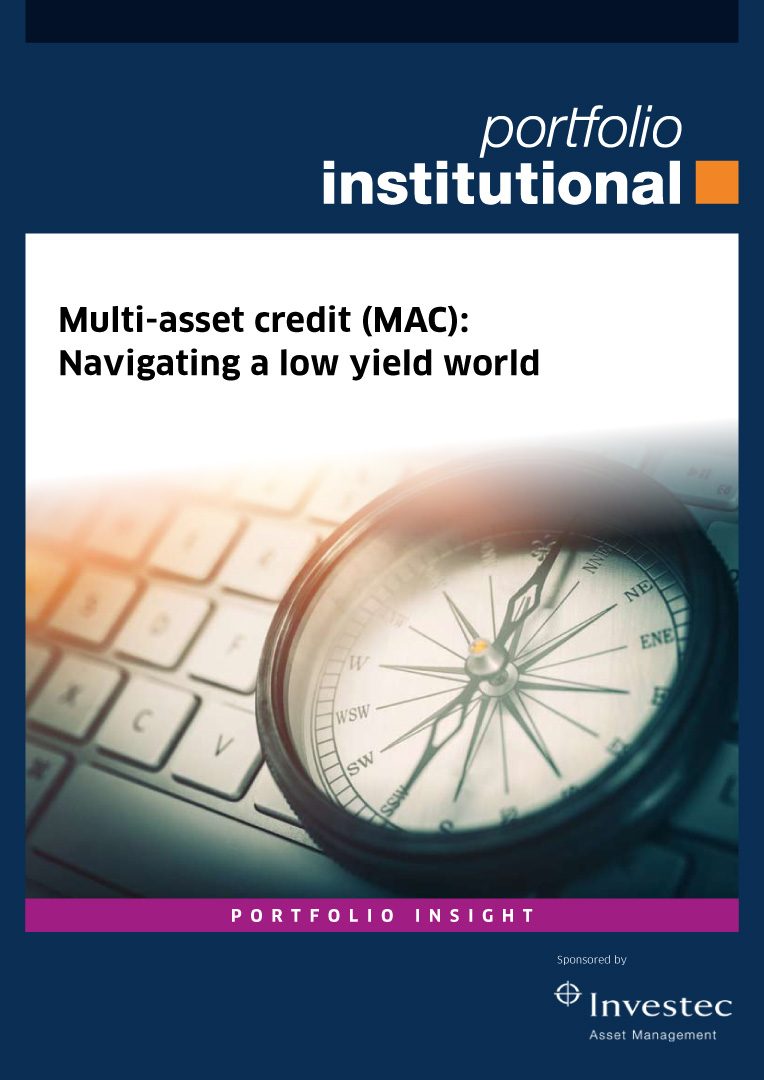Lending money appears to be an easy concept. You lend an individual, company, bank or country money for which you receive regular interest payments until the principle is returned on an agreed date. Yet experienced credit investors know that it is much more complex than that.
Risk is a major consideration when building a credit portfolio. Alongside the borrower defaulting, exposure to interest rate and currency movements need to be factored in while protecting investors from the volatility that is expected to become part of the landscape going forward.
One way to manage this is to build a portfolio that houses different forms of credit, be it direct lending, investmentgrade corporate, high yield, leveraged loans, or the more specialist sub-credit sectors.
While there is no shortage of options for investors looking to build a credit portfolio, on the following pages Investec Asset Management’s MAC team explains how they assess price, risk and return when building a credit strategy.
Investec’s MAC opportunity: Dynamic. Diversified. Defensive.
Credit is a diverse investment class, covering different asset types, maturities, regions and risks. Investec’s multi-asset credit (MAC) strategy is one way of navigating through the complex world of multi-asset credit. It targets higher yields while controlling risk by diversifying across different credit segments.
Its approach is bottom-up driven, actively managed, has low sensitivity to interest rates and takes the operational burden off investors.
Here, Investec’s MAC team explain why investors should consider multi-asset credit and how they work to meet target returns while minimising risk.
MAC – FOR TODAY’S FIXED INCOME MARKETS
It’s been a strong year for the fixed income markets, fuelled by a strong rates-based rally. However, the rally has centered on defensive assets and that’s a reflection of where we are in the cycle. It also has not been uniformed and parts of the market have started to look increasingly expensive and a little vulnerable given the strength of the rally we have seen.
A core defensive building block for investors portfolios has been government bonds, which in the past have generated attractive yields. That has gone away to an extent, given the rally we have had in bond markets.
A third of bonds around $17trn (£13.1trn) – are negative yielding, according to Bloomberg data from August 2019. There are question marks over how low yields can go. If interest rates increase, government bonds are vulnerable to significant capital losses. We believe MAC is a means of plugging that gap and providing a defensive yield in a non-interest rate sensitive manner.
MAC seeks to achieve an attractive yield in a yield-challenged world.
Looking at the spectrum of MAC strategies available in the market, there are some higher-octane strategies looking for higher returns with higher levels of risk as well as some defensive strategies. The majority of MAC managers, including our own, fit into the middle ground, seeking cash plus 4% to 5%. However, within this subset there are numerous ways managers aim to achieve this return profile.
A MAC approach, where the manager has a lot more levers to manage through different environments, we believe, leads to a better outcome.
It’s the opportunity provided by having divergent performance across different credit asset classes but, importantly, also in terms of how MAC can manage the downside. This is the big appeal of MAC strategies to many investors; getting attractive yield but with good downside management.
BOTTOM UP & GENUINELY DIVERSIFIED
There are various ways managers approach MAC. Some are top-down driven, for example, by making a call that US high yield will outperform European high yield.
What we do at Investec is very much bottom-up driven based on where we see value. We use the phrase “pulled to value”. One of the beauties of credit markets is that there are significant inefficiencies in the way credit risk is priced. That comes down to local supply/demand dynamics, the construct of markets, and even the stickiness of the investor base. When we look at a particular credit, it will often issue bonds or loans in multiple markets but the spread you could earn on that will differ from market to market because of those different dynamics or technicals within those markets.
Using a bottom-up analysis, we are assessing where we get best paid for a given level of risk. That is the primary driver of our asset allocation. Seeing more opportunity or certain markets re-pricing over other markets, that drives the asset allocation.
Our fundamental analysis allows us to deliver far more consistently than taking big top-down calls, where the outcome is more binary and the error rate can be high. The other big differentiator is our willingness to use not only the breadth of opportunity sets – we have different levers and different markets to invest in – but a willingness to move within these markets over time.
This means that our asset allocation relative to a lot of our peers has historically shown a lot more dynamism.
And where certain parts of the credit market become expensive or vulnerable from a technical perspective, we do not want to be in those markets. Consequently, we have held zero allocations in pretty much all of our markets at different points. Then there have been times we have had as much as 40% of our assets invested in the core credit segments. Many of our peers have a long-term structural allocation to certain markets, while we are fundamentally driven by where we are getting best paid. We will not maintain a structural allocation to certain markets just for the sake of it.
MEETING THE NEEDS OF TODAY’S PENSION FUNDS
The advantage of a MAC strategy is that it can fulfil a variety of needs for pension funds.
For smaller pension funds, MAC can be a fixed income solution rather than trustees having to decide when to invest in investment grade or what an allocation to high yield should be.
MAC gives pension schemes the opportunity to outsource their fixed income strategy whilst accessing a variety of markets.
At the other end of the spectrum, MAC offers opportunities for bigger pension funds looking for attractive returns but not taking too much incremental risk. Maybe they want to substitute some of their investment-grade bond allocation into a MAC solution. It offers a little extra yield but also attractive drawdown characteristics.
For others it could be that they have had a great run with high yield but are worried about where we are in the cycle. Again, MAC can be that substitute by offering a similar upside but with better downside.
Pension funds could also use MAC as part of a de-risking strategy. So pension funds which have had a great run from an equity standpoint and are looking to take a few chips off the table but not get too defensive; that’s where MAC comes in. Our flagship strategy seeks returns in excess of Libor plus 4% p. a*. An attractive return profile but with historically far more compelling drawdown characteristics than equity.
Trustees on a DB pension plan are ultimately trying to get back to full funding or to a funding level where they can approach a buy-out or buy-in. Over the past five or six years their funding level has jumped from say 70% to above 90%. They are now looking at maintaining and improving that funding level. They want to stay in something that could deliver attractive returns but equally has the dynamism and the defensiveness that will protect the overall portfolio during difficult times. That is a fear for trustees, if you go back to a 2008 scenario, your funding level collapses.
For the DC pension plan trustee, the biggest concern is member awareness and willingness to stay invested. What scares the individual DC trustee are huge drawdowns: Members announcing that they are not going to put any more money into their pension. Yet most new savers are going to be in their DC plan for 30 to 40 years so they will need to be invested in something that can create an attractive yields and strong total return. Our version of MAC has the dynamism and defensiveness that, should the tide turn, could offer some protection.
MAC – A DYNAMIC APPROACH SEEKING TO UNEARTH THE BEST OPPORTUNITIES
People are asking when the cycle is going to end and we believe that MAC can help protect them against those risks.
We believe MAC is the perfect strategy for that question. If a pension fund has had a great run within the high yield market postfinancial crisis, the natural question is when do I get out of it? When do I draw a line under it?
By the same token, if you have been invested in investment grade, with the rally we have had, when does that reverse out?
Trustees are undoubtedly exposed to these questions if they are invested in individual credit markets and are not dynamically adjusting to the environment. MAC is ideal because it gives managers more levers to manage such scenarios. If markets do go into reverse, undoubtedly there will be a huge opportunity for dynamic managers, as you see divergence in the performance of different asset classes. That’s exciting as a MAC manager. If one segment of the credit market sells off significantly more than another, it opens opportunities for us to add a huge amount of value, but investors need to move quickly.
These sell offs and corrections happen fast, making asset allocation calls exceptionally difficult for pension funds that are one step removed. Whereas being at the coalface and ready to move quickly, those are things that we can capture.
In this environment, with the levers we can pull, we are still generating an attractive yield but, as markets tighten in, it typically is more about capital preservation, managing and protecting the downside and waiting for a correction.
MAC: Bottom-up thinking
Garland Hansmann, a portfolio manager in Investec’s Multi-Asset Credit Strategy team, tells portfolio institutional about what makes their approach different in the growing multi-asset credit (MAC) market.
What asset classes, sectors and regions feature in your investment universe?
We cover a wide spectrum of credit. This means standard segments, such as global high yield, global investment grade and global corporate loans, as well as more niche areas like structured credit, which for us means collateralised loan obligations (CLO).
There is also emerging market corporate credit where the issuer is based outside of the developed market. We also think about specialist markets such as corporate hybrids or bank capital, which are subordinated forms of debt from investment-grade issuers.
The short duration markets within credit have their own risk-return profile and supply and demand dynamic, so we single them out and treat them as their own little market. These are the areas in which we hunt.
So what credit assets are you bullish on?
We tend not say: “Here is a particular area that we think is hot. Let’s jump into that with both feet and see what we can find.” In fact, it works the other way around. We like to describe it as being “pulled by value”. We look at the type of return we are trying to generate and the risk we are willing to accept and then look at all markets to pick out the individual securities that fit best. It is bottom-up driven and individually security driven.
We have recently had a high degree of success in finding those types of deals in structured credit. We are getting lower returns here than the Libor + 4% we tend to look for, but we are getting a return with a high underlying credit quality and with low risk. These bonds are AAA or AA rated and gives us between 120 and 180 basis points over Libor. That is quite attractive if you think about the near zero risk that you are taking in credit terms.
Corporate hybrids are another area that have been strong contributors to return recently. These are typically subordinated debt issued by investment-grade companies. The interesting aspect around that, from a credit perspective, is that they are a low credit risk. From a market price behavioural aspect, they perform more like high yield bonds in that they have big price moves.
When spreads get tighter, covenants get lighter and competition for assets gets higher, we back off.
Considering that we are potentially at the backend of the economic cycle, if you can find something that gives you a higher return by prices moving and attractive coupons but has an underlying defensive credit profile, then it’s a great investment. That has helped the fund out recently.
How are you exploiting inefficiencies in credit markets?
There are some markets that have a high degree of efficiency. Large cap equity or government bonds come to mind. Then there are markets that have lower degrees of efficiency, which you can exploit.
One of the reasons why efficiencies are permanent in credit markets is that there are rating biases. Many investors’ investment policy from a regulatory perspective is sometimes tied to the rating.
There is also something we call the “home bias” where a company based in Europe or the UK issuing in dollars typically pays a wider spread in a foreign currency market and vice versa because that issuer is not as well known.
Structures like ETFs distort markets further by having a liquidity profile that is different to that of the underlying market.
There are various reasons why credit markets are permanently inefficient, and we try to harness those inefficiencies to improve the returns for the risks we are taking. We are always about taking what we believe to be the best risk-return profile into the portfolio.
How does your approach to MAC differ from other asset managers?
Many traditional credit investors run against benchmarks, so their objective and the way they manage the fund is different to us. We are a total return-oriented investor.
We are trying to achieve a return over time with the minimum amount of risk. That is a different approach to meeting or beating a benchmark, where risk is not even a consideration.
Multi-asset credit as a category has grown recently. Many of these managers typically take a different approach to us with the most common approach in this area being: “What is the hot area?” This is a top-down managed approach. A look at how individual subsegments of credit have performed over time shows that there is an enormous variability between segments. Identifying ahead of the fact which segment is going to do well and which might struggle is challenging. To do that consistently over time, quarterby-quarter, year-by-year, is extremely challenging. This is why we developed a bottomup approach seeking individual opportunities that help us to achieve our risk and return targets.
In that regard we are quite different from our peers. That shows in the numbers because when the drawdown period comes, when the market goes through a difficult time, our fund holds up extremely well compared to the individual segments that go into it and often at times when compared to our peers.
A look at the change within the fund provides further evidence that we do things slightly different to our peers. If you look at how the fund was structured last week, compared to how it was structured in the last quarter or last year, you will see enormous value created by our team. It is that dynamism, that activity of management and being willing to move the fund around and find individual outstanding opportunities that differentiates us from many other managers of more strategic or static funds.
Due to the popularity of some credit asset classes, such as direct lending, are you taking more risk for lower returns?
As spreads tighten and lending conditions become more competitive, many people would be willing to take more risk to achieve their target return. We go the other way. When spreads get tighter, covenants get lighter and competition for assets gets higher, we back off.
We are willing to under-yield our return target for a period to protect capital, to make sure that we are not taking excessive risk just because the competitive situation requires it.
One of the reasons why efficiencies are permanent in credit markets is that there are rating biases.
We do not target a yield; we target a return on average over time. That means, in periods as we are in now, we tend to get more defensive.
When other investors are doing riskier deals with poor covenants and tight spreads, we aim to protect our money, we keep our powder dry. This is one of the reasons why I mentioned our large exposure to AAA and AA tranches of the CLO market. That is a way we can get out of areas that are competitive and into assets where we can protect future returns and minimise the downside
Is this how you are preparing for the end of the credit cycle?
The end of this credit cycle seems to have been upon us for about three years and we are still waiting for it to materialise. It is the never-ending credit cycle.
It may well be the end of the credit cycle, but it might last another year, another 24 months or maybe even longer. From that perspective, we do not want to make these difficult big top-down positioning calls. We would rather take a bottom-up, deal-by-deal approach to find sensibly priced risk.
In an environment such as this, we tend to to stay clear of segments which are competitive and where you are not being paid for the risk. Instead we focus on areas that are more attractive, maybe more defensive, but we are not quite as defensive as we were towards the end of 2018.
In the fourth quarter of last year the fund had, on average, investment-grade ratings of BB. The fund is quite dynamic, so in an extreme case it might have a B credit rating, on average. In a defensive positioning, it might have a BBB rating, and in the fourth quarter of last year that was the case.
We weathered that storm extraordinarily well. We had one of the lowest drawdown ratios in the market compared to our peers. That is an example of how the fund can be positioned defensively.
We are not that defensively positioned today with an average credit rating of BB+, which in the scheme of things maybe slightly more conservative than the fund’s historical average.





